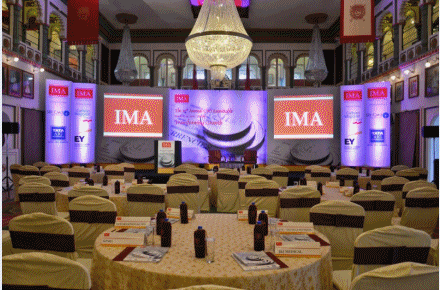About Us
IMA India is the country’s largest peer group platform for top functional executives, comprising more than 2,500 Indian and global business/functional heads from over 1,400 member companies. Since 1994, we have developed an unmatched capability to harness and distil collective wisdom, enabling top managers and industry leaders to interpret changes and forecast developments in the operating environment through authoritative guidance
IMA is a niche economic, business and market research firm that provides insights and analysis to top management audiences in India through multiple channels. For over two decades, IMA’s research and opinion has informed the perspectives of investors, industry and government. IMA is the country’s largest peer group platform for top functional executives, comprising more than 2,500 Indian and global business/functional heads from over 1,500 member companies. Since 1994, we have developed an unmatched capability to harness and distil collective wisdom, enabling top managers and industry leaders to interpret changes and forecast developments in the operating environment through authoritative guidance.

- Membership-based services for top business managers
- Provision of knowledge through briefings and research content
- Four forums run across 6 cities of India
- Affiliate services across the Asia Pacific

- Incisive market and industry research
- Economic analysis
- Benchmarking studies
- Proprietary studies for individual clients across issues and sectors
- Leveraging IMA India’s vast network to gather insights and learnings

- Country conclaves dedicated to CEOs, CFOs, CHROs and CMOs
- Closed-door platforms for senior executives to debate cutting-edge business issues
- Driven by intensely-researched agendas, selective audiences and authoritative speakers and panellists

- A first-of-its-kind quarterly journal focussing on corporate strategy and finance – effective readership of 12,000 top executives
IMA ’s four retainer-based, peer-group briefing services – for CEOs, CFOs, Chief Human Resource Officers and CMOs – provide incisive country intelligence and management insight to over 1,400 member companies. A unique model – built around closed-door briefing sessions, research updates and analyses, and access to IMA India’s research databases – ensures that the Forums deliver independent and effective insights to business leaders and top managers.
’s four retainer-based, peer-group briefing services – for CEOs, CFOs, Chief Human Resource Officers and CMOs – provide incisive country intelligence and management insight to over 1,400 member companies. A unique model – built around closed-door briefing sessions, research updates and analyses, and access to IMA India’s research databases – ensures that the Forums deliver independent and effective insights to business leaders and top managers.
- Regular briefing sessions are hosted in the Delhi NCR region, Mumbai, Bangalore, Chennai, Pune and Hyderabad. Centring on the most relevant business and economic issues, they are led by authoritative speakers from the worlds of business, government, and civil society. Sessions are closed-door and interactive, and discussions are intense, frank and ultimately, highly practical.
- Members have access to IMA India’s extensive and ongoing research on the business environment. This includes our independent analysis and opinions on the Indian, Asian and global economies, strategic and political affairs, industry and market developments, emerging management paradigms, and other topics of relevance to top business leaders.
- Access to our Knowledge Centre and ‘on call’ access to our research team provide quick answers to specific data needs.
- Once a year, India CEO Forum members may also call upon a senior IMA executive to provide a personalised country briefing to company executives or head-office visitors.
To know more regarding IMA's Peer Group Forums membership please write to us
 The greatest knowledge resides in the minds of those that are practicing cutting-edge management techniques, developing novel approaches to business problems, or taking decisions that affect businesses and societal outcomes. IMA’s Conferences and Roundtables aim to bring these individuals together in an ongoing effort to discover new insight and generate fresh perspectives.
The greatest knowledge resides in the minds of those that are practicing cutting-edge management techniques, developing novel approaches to business problems, or taking decisions that affect businesses and societal outcomes. IMA’s Conferences and Roundtables aim to bring these individuals together in an ongoing effort to discover new insight and generate fresh perspectives.
Our meetings are designed to facilitate intellectual exchanges within a peer audience of pioneers, business leaders and other decision makers. Ranging from half-day workshops to 3-day offsite initiatives, our conferences are uniformly driven by intensely-researched agendas, carefully selected audiences, closed-door discussions, and authoritative speakers and panellists. To maintain a senior and serious audience, we receive invited guests only and also levy a fee for participation.
IMA’s calendar of conferences includes The Annual CEO Roundtable (now in its 19th year), The Annual CFO Roundtable (now in its 20th year), The Annual CFO Strategy Roundtable (now in its 10th year), and a number of other function-specific or sector-focussed conferences.
For businesses that seek a senior corporate audience and have intellectual value to offer, IMA India conferences present ideal sponsorship platforms. Unique opportunities to establish thought-leadership and build a professional network within a senior audience, have attracted some of the best known companies to associate with our meetings.
Partner with IMA for a off-site conference and reach out to the leading CXO's of India. Write to us to know more about our partner programmes.
Launched in 2006, CFO Connect® is a first-of-its-kind thought-leadership magazine for CFOs and other senior finance professionals. Published monthly, it offers concise and informed analysis on the operating environment, together with thought-provoking and incisive writing on matters of finance, corporate strategy and leadership. Unlike most technical and accounting journals, CFO Connect deals with the broader strategic and leadership challenges of managing the modern-day corporate finance function. Recognising that the role of the CFO goes well beyond mere accounting/controllership, the magazines aims to identify and promote Finance best practices. Equally, it seeks to facilitate a greater 'share of voice' for this community, and to help shape the corporate and regulatory landscape. Supported by IMA India's team of experienced analysts and commentators, CFO Connect draws upon the intellect and experience of India's most authoritative CFOs, thought/opinion leaders and policymakers.
Contribute
CFO Connect is a journal for CFOs and other senior finance professionals, covering a range of topics relevance to this audience. Should you wish to contribute, please write to us introducing yourself and providing a brief description of what you would like to write on.
Advertise with CFO Connect and CFO-Connect.com
The CFO’s role has changed dramatically in the last 10 years. From being a mere ‘bean counter’, today’s CFO is truly to a strategic partner to the CEO, commanding greater authority than ever. Increasingly, CFOs are involved in making big decisions for their companies, in areas as diverse as real estate investments and IT upgrades. They are also high net-worth consumers in their own right, purchasing a variety of luxury products and services, from premium cars to exotic holidays. CFO Connect is a highly-targeted and efficient way to reach out to this important audience.
Contact us to advertise in CFO Connect.
As explained in IMA India’s recent economic updates, we expect gross domestic product to rise by 6.4 per cent in 2017-18 and a slightly higher rate in the coming year. Output understandably took a bump in the wake of demonetisation and the subsequent roll-out of goods and services tax (GST). However, we believe these are largely behind us and recovery, going forward, should be robust and sustained. The fact is, consumption has been strong and constitutes the principal driver for growth with investment lagging behind. Be that as it may, in the years ahead the impact of certain government initiatives will play out favourably, as this editorial will in subsequent paragraphs seek to explain. +Read
Global bond yields have, over the past few months, started to rise as markets expect inflation to perk up and central banks shift gears towards a more hawkish monetary stance. The United States Federal Reserve, a few months ago, declared its intent to start the process of unwinding its previous bond purchases and therefore shrink liquidity. US bond yields consequently spiked to 2.74 per cent. German treasury bills too have risen from 0.41 per cent to 0.77 per cent over the past twelve months, prodded by comments from Mario Draghi, the head of the European Central Bank, that future bond purchases by the ECB will begin to moderate. All of this is in the backdrop of robust economic growth in America at 2.3 per cent and in the Eurozone at 2.5 per cent last year. Since the global financial crisis, central banks kept credit markets functioning, bailed out banks and provided assurances to wobbly bond markets. Perhaps, the protracted era of bonhomie is coming to an end as the interest rate cycle begins to turn. +Read
In the editorial of the February 2018 edition of CFO Connect, “Different Strokes”, I referred to the benefits of the redeployment of savings from gold to financial instruments. The surge in yields for households could conceivably be anywhere between 1.5% and 6% of annual income. Moreover, there are tangible savings when money is borrowed from banks and micro finance companies, instead of traditional informal sources that a large chunk of the rural population currently depends upon. The reduction in interest cost could lie between 2% and 4% of income per annum. Even real estate investments, especially those in utilised commercial properties create economic churn and are therefore, productive. However, what is completely unproductive from even the most generous benchmarks is gold. +Read
Uday: A Federalist Success Story
Electricity distribution has been disastrously managed over the last three decades and in 2015 was on the verge of absolute collapse. Underpriced power, operational inefficiency, broken equipment, rampant theft and political meddling had resulted in distribution companies (discoms) hoarding losses of Rs 4 trillion on their books. +Read
Over the past few months, there has been growing debate on the per formance of the Modi administration. Sceptics have argued that things are stumbling and have used events such as the aftermath of demonetisation, GST implementation slippages and more recently, a drop in GDP output, as the basis of their contention. +Read
Over the course of the last few years American equities, reflected in the value of the Dow 30 index, have spiked and some would argue, beyond reason. So has the more representative S&P 500, together with bonds and property. A quick scan of the PE ratios of the S&P 500 index since 1926 reveals 10 instances when sceptics may have had cause for concern that a bubble was forming. +Read
A lacklustre performance of the economy in the April-June quarter created a sense of unease amongst industry watchers. More recently, the media was abuzz with news about the Government’s intent to pump prime the economy with a spending binge in the hope that private capital would follow. Quite expectedly the markets panicked on the premise that the treasury would exceed its fiscal targets. +Read
On a certain date each year in October, just past the midnight hour, the Government of the Kingdom of Norway posts online the annual tax returns of all its citizens. The list contains every taxpayer’s total income and the tax paid. Any Norwegian can discover at the click of a button, how he compares with his neighbour, with the yes-man who plods away across the aisle at the office or indeed the local politician who rants about a more equitable society. +Read
On the 1st of July, India transitioned to a Goods and Services Tax (GST) regime where a multitude of indirect taxes were replaced by a single levy. So far, it is still a policy in the making with new rules emerging on a frequent basis, necessitating repeated changes to ERP systems and accounting protocols. Clearly, everybody is learning on the job. The GST seeks not only to simplify the tax chain but, more significantly, to widen the tax net. India’s large ‘informal sector’ has historically enjoyed a tax arbitrage which the GST seeks to eliminate. +Read
The paper provides an analysis to show that farm loan waivers are fiscally damaging and provide no lasting benefit for farmers and will actually lead to a decline in aggregate consumption and GDP growth in addition to other damaging consequences. The thinking behind such waivers is naive and based on a simplistic understanding of farmer indebtedness. +Read
The Transmission of Interest Rates
Over the last 16 months, the RBI has cut the repo rate by only 50 bps. Its hesitation in cutting rates too fast is prudent as US dollar interest rates were rising and inflationary risks had not fully subsided. There is a third and more structural reason, which is the inefficiency of the domestic monetary transmission system. +Read
The subject of the constitution of Boards and their effectiveness has been hashed for years in academic journals and business magazines. There are, in fact, enough insights on this to sink a ship. This piece will not preach the gospel nor repeat well-established truths. It simply offers some observations on the facets and responsibilities of Boards, specifically in Indian family-run businesses. +Read
Trump card
It is now evident that the promises made by President Donald Trump were not all election rhetoric, and he intends to honour them. Some of his measures threaten to reverse decades of settled policy positions by the US in the domain of trade, foreign affairs and social issues. As far as India is concerned, there are reasons to believe that the Trump administration will be favourably disposed, though the issue of visa restrictions will remain a thorn. +Read
Gain for Pain
The debate on demonetisation has become charged with ideological overtones and an excessive reliance on anecdotal evidence. However, it is essential that facts and economic logic are not ignored. There are serious flaws within India's economic architecture which demonetisation seeks to correct. While the pain is not over yet, there are indications that the gains it seeks to achieve are perhaps within reach and the exercise may yet turn out to be a game changer. +Read
Since 2011, the US dollar has risen 40% against a basket of currencies. Going forward, it may strengthen even more. The Trump administration is likely to commit to a major infrastructure spending programme. Together with tax cuts, friendlier business regulations and higher interest rates, this will attract large volumes of capital back into the US economy, boosting its currency in the process. The rest of the world, particularly emerging markets, will have some ramifications to grapple with. +Read
In the immediate aftermath of the demonetisation of high value notes, retail consumption and transactions in sectors with a large cash component dropped. Proponents argue that the inconvenience to society is a temporary and small cost for a larger cause, while sceptics claim that this is unlikely to win the battle against black money and the economic consequences are unclear. The fact is that if suitable follow up efforts are undertaken, the results may yet surprise on the upside. +Read
A recovery? It depends on who's asking
In recent months, conventional indicators have been generating conflicting signals with respect to the nature and pace of India’s economic recovery. GDP growth suggests robustness, rising from under 5% to over 7.5%. However, other indicators such as IIP growth, bank credit expansion and capacity utilisation levels, seem to assert the opposite. A deeper analysis would seem warranted, and as this paper explains, there is more to this picture. +Read
When the mirror cracks from side to side
When hit by crises, the experiences of companies suggest that those that weather the storm safely do so by following a few simple principles. For instance, they proactively assess threats, establish clear chains of command, articulate a well-defined risk tolerance policy and above all, ensure that their communications are honest and promises, sincere. Attempts to suppress facts, disown responsibility or obfuscate the truth can backfire, as many prominent examples in the recent past have demonstrated. +Read
A Double-Edged Sword
The large quantitative easing programmes launched by central banks worldwide in the aftermath of the global financial crisis were aimed at rescuing their economies from the throes of recession. While they may have succeeded to some extent, they come with longer-term downsides. They have created an era of cheap money that will see every asset class deliver low returns for the next 5-7 years. As this paper explains, there are other, more serious, consequences too. +Read
The Silent Revolution
The remarkable increase in the volume of electronic funds transfers (EFTs), Immediate Payment Services (IMPS), mobile banking and pre-paid payment instruments (PPIs) testifies to the popularity of digital payments systems in India. The next big 'push' will come from the Unified Payments Interface (UPI). This will allow anyone with a smart phone and bank account to make instant money transfers. As this paper explains, it is a seamless, inter-operable and two-way payment system with many advantages. +Read
Rise of the Digital Matrix
Social networks started out as mediums to help individuals connect with each other. However, as the numbers grew, they became more serious platforms with the ability to sway mass opinion and alter social behaviour. With over 2.1 billion users globally, digital forums such as Facebook, LinkedIn, Twitter and Instagram have understandably become critical channels for businesses to reach out to, and influence, consumers and employees. As this paper explains, they are doing this in many different ways. +Read
The Name is Bond
The lack of an active bond market in India has led to an over-reliance on the banking system to fund the nation's infrastructure and economic development. This is neither adequate nor sustainable and in the long term, a market for fixed income securities is essential. In August, the RBI announced several measures towards this objective, including allowing the use of corporate bonds under its Liquidity Adjustment Facility and raising the limit under the partial credit enhancement mechanism. +Read
Goods and Services Tax
The GST Constitutional Bill was recently approved in the Upper House of Parliament. This paper examines the GST on the count of several factors such as ease of administration, the rate of tax, flexibility conditions, and exemptions and exclusions. While the passage of the Bill is a big milestone in itself, there are important issues that need further consideration, and hopefully, this will happen in the months ahead. +Read
A Credit Quandary, but much more
Analysts are concerned that industrial investments are subdued and the capital goods IIP has been in negative territory for a few months. However, a more detailed analysis suggests that the picture is not quite as bad and, equally, that it was not quite as rosy in earlier years as many had believed. Actual investment is in fact showing signs of a pick-up in 2016, but, as this paper explains, much more still needs to be done. +Read
Following the Brexit vote in June 2016, equities and bond yields collapsed, the Pound fell to a 30-year low and the Euro and emerging market currencies dropped. Thereafter, they calmed to a degree, mainly due to indications from the US Fed that a hike in interest rates would be deferred. Labour market conditions within the US have also been deteriorating, and the Brexit vote pushed the decision in favour of restraint. +Read
The Matrix Reloaded
Two decades ago, most MNCs were organised on a geographical structure. Over time, this has been replaced by matrix structures wherein revenue or sales responsibility vests with product or unit heads who report to their direct superiors overseas. The country CEO remains responsible for governance, compliance and sometimes support functions such as HR and finance as well. As this paper explains, while matrices have served their purpose well, their success hinges on several important ingredients. +Read
An Island Nation Again
The referendum on EU membership held by Great Britain on June 23 was triggered largely by the issue of immigration. However, by voting to leave the common market, the majority perhaps voted with their hearts rather than their minds, and without sufficient comprehension of what may follow. As this paper explains, Brexit will have a profound impact not only on economic matters, but on British and European politics as well as strategic considerations. +Read
The Fine Innings
Dr Raghuram Rajan assumed charge as Governor of the RBI in September 2013. During his term, he played an instrumental role in averting a currency and BoP crisis and subsequently bringing a host of economic parameters within a range of comfort. He guarded the independence of the RBI, ushered fresh competition into the banking industry and took several measures to reform India's financial sector. As this paper explains, his presence benefitted the Indian economy in many ways. +Read
After Seven Years of Sunshine
Asset markets across the world rallied smartly in the first half of 2016. Equities recovered a large part of their 2015 losses, and bond spreads in both American and emerging markets moderated perceptibly. However, it is far from assured that things will continue to get better. The rally is mainly an outcome of specific events that are extraneous and impermanent, and risks to the global economy are tilted to the downside. +Read
Changing Terms of Engagement
Entrepreneurism is the backbone of a market economy, and there are signs of a vibrant culture for start-up businesses coming about in India. However, the focus on garnering scale and acquiring customers, or sometimes even seeking glory through slick technologies, results in profits and cash flows taking a back seat. This must be guarded against, and it is important that the ultimate goal of a business - to generate positive cash flows - is not lost sight of. +Read
The Real Estate Act : A Good Begnining
In March 2016, Parliament enacted the Real Estate (Regulation and Development) Act. The Act seeks to address shortcomings of the sector through provisions aimed at protecting consumer interest and enforcing accountability upon service providers. The challenges are immense - land is a state subject, builders are an entrenched lobby, and local authorities are corrupt and inefficient. While no law could be expected to solve all problems, the Real Estate Act is, by most accounts, a fine piece of legislation. +Read
Valuations : Optimistic or Desperate ?
The valuations of internet start-up companies have grown exponentially. The 'unicorn club'-start-ups valued at USD 1 billion or above-has grown from 39 companies in November 2013 to 229 in January 2016. Carried out away from the scrutiny of public markets and regulators, many of these valuations seem to defy logic. Such a phenomenon would ultimately lead to the creation of a bubble. However, as this paper explains, an important counter trend is taking shape that can have a moderating influence. +Read
The Aadhaar Act: a game changer
The Government recently notified the Aadhaar (Targeted Delivery of Financial and Other Subsidies, Benefits and Services) Act, 2016. This allows it to formally link the provision of subsidies and other welfare payments to Aadhar numbers, thereby eliminating duplication and pilferage while also enabling transfers through direct bank remittances. This will enable significant fiscal savings, and can, even under conservative assumptions, lead to savings of 1.2% of GDP on the count of federal subsidies alone. +Read

Adit Jain, Chairman and Editorial Director, IMA India
Adit Jain established IMA India, an economic and business research company, in 1991. He continues to serve as its Chairman and Editorial Director. Previously, Adit worked with Lazard, an investment bank, as Vice President and Head, Mergers & Acquisitions. Over the years, Adit has advised companies on their India strategy, deposed as an expert witness at commercial litigations in the United States and given testimony at Parliamentary proceedings. In his current role, he provides briefings to company boards and speaks at emerging market seminars across the Asia Pacific region. Adit has lectured on business policy as Adjunct Faculty at the Indian Institute of Foreign Trade (IIFT) and International Management Institute (IMI).
Over the years, Adit has authored over a thousand articles in the domain of economics, politics, international affairs, conservation and management practices. His writings frequently focus on the economic role of Governments. He is Editor of IMA India’s quarterly country report, The Operating Environment Assessment Paper and CFO Connect, a monthly magazine for the finance community in India. He is also the firm’s principal economic commentator.
Adit is a Non Executive Director on the boards of Sanmar Holdings, BMR Advisers and PR Pundit Public Relations. He previously served on the boards of Shriram Transport Finance Limited, Engineers India Limited, Certification Engineers International Limited, Mahanagar Telephone Nigam Limited and Indosolar Limited.
In his previous role at Lazard, Adit advised on several global M&A transactions and other aspects of corporate finance. Prior to returning to India in 1991, he worked in the United Kingdom for approximately 8 years, initially with MB Wild as Project Engineer, and subsequently, with Stag Holdings plc, as Strategy Director. He started his career in Calcutta (now Kolkata) with McNally Bharat Engineering Company.
 Adit works closely with forest authorities at the Kanha National Park and the Pench Tiger Reserve in Madhya Pradesh, towards education, community and social initiatives. His privately-funded foundation sponsors the education of hundreds of school children in India and Nepal. In 2009, Adit was elected a Fellow of the Royal Geographical Society, London. A keen wildlife photographer, he travels extensively in the Himalayas and spends time at National Parks in India and East Africa. Adit has a bachelor’s degree in mechanical engineering from the Birla Institute of Technology (BIT), Mesra, India, and a master’s degree in business administration from the Henley Business School, UK.
Adit works closely with forest authorities at the Kanha National Park and the Pench Tiger Reserve in Madhya Pradesh, towards education, community and social initiatives. His privately-funded foundation sponsors the education of hundreds of school children in India and Nepal. In 2009, Adit was elected a Fellow of the Royal Geographical Society, London. A keen wildlife photographer, he travels extensively in the Himalayas and spends time at National Parks in India and East Africa. Adit has a bachelor’s degree in mechanical engineering from the Birla Institute of Technology (BIT), Mesra, India, and a master’s degree in business administration from the Henley Business School, UK.
Copyright ©️ 2021-22 INTERNATIONAL MARKET ASSESSMENT INDIA PRIVATE LIMITED. All rights reserved







